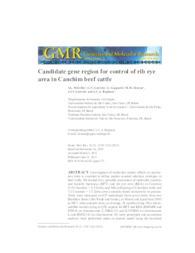Candidate gene region for control of rib eye area in Canchim beef cattle.
Candidate gene region for control of rib eye area in Canchim beef cattle.
Autoria: MEIRELLES, S. L.; GOUVEIA, G. V.; GASPARIN, G.; ALENCAR, M. M. de; GOUVEIA, J. J. S.; REGITANO, L. C. de A.
Resumo: Investigation of molecular marker effects on production traits is essential to define marker assisted selection strategies in beef cattle. We looked for a possible association of molecular markers and backfat thickness (BFT) and rib eye area (REA) in Canchim (5/8 Charolais + 3/8 Zebu) and MA (offspring of Charolais bulls and 1/2 Canchim + 1/2 Zebu cows) animals raised exclusively on pasture. Traits were measured on 987 individuals from seven herds from two Brazilian States (São Paulo and Goiás), in March and April from 2005 to 2007, when animals were, on average, 19 months of age. Five microsatellite markers lying in QTL regions for BFT and REA (BMS490 and ETH10 on chromosome 5, INRA133 and ILSTS090 on chromosome 6, and BMS2142 on chromosome 19) were genotyped and association analyses were performed under an animal model using the restricted Candidate gene region for control of rib eye area maximum likelihood method. After correction for multiple tests, a significant effect of microsatellite BMS490 on REA was observed, suggesting that at least one QTL affecting carcass traits in this region of the BTA5. No significant effect on BFT was observed for these markers.
Ano de publicação: 2011
Tipo de publicação: Artigo de periódico
Unidade: Embrapa Pecuária Sudeste
Palavras-chave: Association study, Carcass traits, Microsatellite markers, cattle
Observações
1 - Por padrão são exibidas publicações dos últimos 20 anos. Para encontrar publicações mais antigas, configure o filtro ano de publicação, colocando o ano a partir do qual você deseja encontrar publicações. O filtro está na coluna da esquerda na busca acima.
2 - Para ler algumas publicações da Embrapa (apenas as que estão em formato ePub), é necessário ter, no celular ou computador, um desses softwares gratuitos. Sistemas Android: Google Play Livros; IOS: iBooks; Windows e Linux: software Calibre.
Acesse outras publicações
Acesse a Base de Dados da Pesquisa Agropecuária (BDPA) para consultar o acervo completo das bibliotecas da Embrapa.

